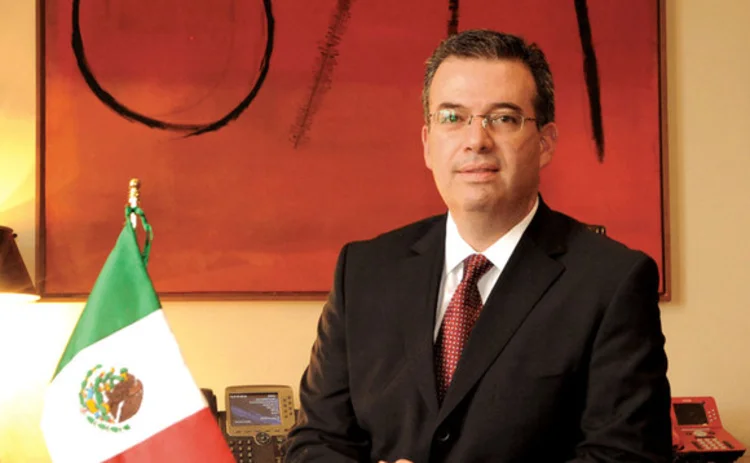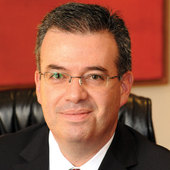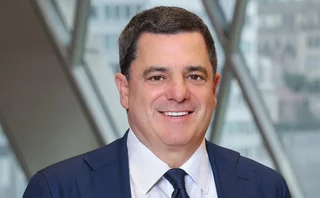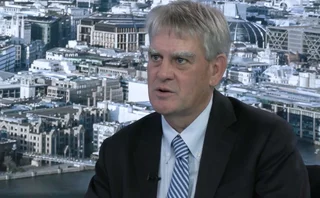
Sovereign risk manager of the year: SHCP
Mexico hedged the dramatic oil price collapse while diversifying its investor base

Risk Awards 2016
With energy prices and central bank monetary policy decisions having significant impacts on global markets, Mexico's decisions to build an advanced oil hedging programme and diversify its long-term debt investor base appear very well judged. But these programmes weren't the result of a snap decision once markets started to move – they were part of a meticulous plan built over the years by a debt management office (DMO) that has the confidence of its government and, more importantly, the market.
"I've covered the region for over 20 years and number one is always Mexico," says Blake Haider, a managing director in the Latin credit markets team at Citi in New York. "I would not think of specific transactions, but of their long-term vision in developing their local capital markets and bringing in international investors. They deserve something like a ‘prize of the decade' for the way they've done that so successfully."
Max Volkov, head of Latin America debt capital markets at Bank of America Merrill Lynch (BAML) in New York, agrees: "They are truly a world-class operation. And that is what they have been doing for the past 20 years," he says.
The most eye-catching of the Secretaría de Hacienda y Crédito Público's (SHCP) achievements this year has been the success of its oil hedging programme. Mexico is the fourth-largest petroleum producer in the Americas and earnings from the industry contribute around a third of its annual revenues, making price volatility a key risk to the country's finances.
Oil prices hit record lows over the past year, with Mayan crude sliding from $56.63 per barrel (bbl) in June to $39.2/bbl in October. But thanks to its oil hedging programme, Mexico made a significant profit from the price collapse, mitigating its impact on the country's finances.
What the hedge did was provide additional time to do the reduction in spending instead of doing it all in one year, with all the drawbacks that entails
Alejandro Díaz de Léon
"The oil hedging programme for 2015 provided $6.3 billion in revenues for the federal government, providing key support for the budget," says Fernando Aportela, undersecretary of the SHCP. "The programme is a key element of Mexico's risk management strategy that eliminates the short-term public finances exposure to oil-price reductions."
The public debt unit of the SHCP, which dictates the hedging strategy to the central bank to execute, locked in the sale of 228 million barrels at $79/bbl for 2015, costing $773 million. For 2016, the unit has already hedged the sale of 212 million barrels at $49/bbl, costing $1.09 billion. With prices currently sitting at around $30/bbl, the hedges already have significant mark-to-market gains.
These hedges will allow the government to transition to a world of lower oil prices gently, reducing spending by 1.5% over at least two years instead of one, says Alejandro Díaz De León Carrillo, who served as head of the Public Credit Unit at the SHCP until December 2015, when he was appointed head of Bancomext, the Mexican development bank.
"Oil hedging in Mexico should be understood as hedging next year's budget in order to avoid having budget cuts once the Congress has already decided what programmes they want to support. While in the long term, this contraction in oil prices may require considering adjustment to expenditures, what the hedge did was provide additional time to do the reduction in spending instead of doing it all in one year, with all the drawbacks that entails," says Díaz de Léon.
"This is very important, because you don't want fiscal policy playing a pro-cyclical role," he adds.
SHCP locked in prices at $79/bbl – the minimum mandated in the 2015 budget – for 228 million barrels of Mexican mix. As there isn't a liquid options contract on the Mexican crude oil mix the country exports, the SHCP uses a combination of Asian put options on Brent and Maya crude oil. Asian put options have a payoff determined by the average price of oil over a full year of exposure, rather than being dependent on a single date or month, during which volatility can spike.
Through a combination of those options, the SHCP was able to lock in an average price of $76.4/bbl of Mexican mix, leaving it with $2.60/bbl of exposure between the price it hedged at and the minimum price per barrel for export considered in the budget. The agency covered the remaining exposure with a separate fund, using cash from previous budget savings.
Mexico also conducted its oil hedging with seven counterparty banks, up from five the previous year – a reflection of dealers' increasing difficulty in warehousing risk.
Bank traders are particularly impressed with the extent the government has supported the SHCP's hedging programme, given the large upfront cost and uncertain performance. Díaz de Léon agrees it isn't always easy selling the idea of oil hedges, but says the government has been very dedicated to the programme – even when it's harder to justify in years when oil prices are stable.
We were quite surprised that in less than two months we were able to issue for the first time in 30 years, and then our first centennial in euros
Alejandro Díaz de Léon
"It is relatively expensive, which is why it isn't that common. You have to pay every year, and you need the discipline and understanding, not only at the government level, but also at the Congress level. We have been selling this to Congress and society in general by communicating with them and telling them it is like buying insurance. If you buy car insurance and you don't crash, that isn't a bad thing, but when you do crash, this insurance will be very helpful. There has been a lot of discipline here in Mexico to avoid short-term exposure to oil prices and to insulate the expenditure already approved by Congress," he says.
On the financing side, Mexico's debt issuance programme over the past year is a continuation of efforts begun in 2008 to boost the diversity of its investor base and build out the curve in several currencies, starting with the US dollar, then sterling, yen and more recently the euro – the latter being an effort to take advantage of Europe's quantitative easing (QE) policies to attract yield-hungry investors.
In March, it issued a nine-year euro-denominated bond, closely followed by its first 30-year issuance. In April, it became the first DMO to issue 100-year securities denominated in euros, which also made it the first DMO to issue century bonds in three different currencies.
"It was remarkable, and we were quite surprised that in less than two months we were able to issue for the first time in 30 years, and then our first centennial in euros," says Díaz de Léon.
The decision to issue out to 100 years is a strategic one that not all debt offices take. The difference in portfolio duration that can be achieved with a 100-year issuance is minimal. However, it allowed Mexico to reach new investors looking for duration as European yields crashed. According to Díaz de Léon, almost 40% of investors in the 100-year euro issuance were not present in the nine- and 30-year issuances.
"What was striking was that 65% of that issue went into the UK and Germany, which is atypical. By getting their 100-year done in an iffy market and getting that dispersion, that is a risk management move on their part. I thought it was very clever for them to take advantage of the disruption in the market, when the European Central Bank was cranking up QE and the German yield curve shifted downward, and so there was a lot of demand from pension funds and insurers who needed long duration and wanted a pick-up in yield," says the head of Latin American debt markets at a large US bank.
The agency says its decision to issue century bonds was also driven by a desire to reduce refinancing risk.
"With the 100-year issuance, you are dealing with a different bucket of the investor base. So if you launch one 30-year and then another 30-year the year after, that benchmark will be really close to the previous one, segmenting liquidity and dividing investor interest for that maturity bucket. So instead, if you do a 100-year, you tap an additional investor base, and you keep the option to issue in different tenors and consolidate stronger benchmarks," says Díaz de Léon.
Diversification is key
Investor diversity is a key goal for the country's Mexican peso-denominated bonds as well, of which 39% currently sits with foreign investors. In the past, the domestic debt market was highly reliant on local pension funds for long-term funding needs, prompting the government to pursue a strategy of greater internationalisation.
"As we have been able to diversify, we have different views about rates and the economy being expressed in the yield curve, allowing for a more stable curve, which performs better and overall reduces our cost of funding," says Díaz de Léon.
While having more foreign investors introduces the risk of cyclical behaviour as foreign exchange rates move, Díaz de Léon says he believes the depth of the local derivatives market allows investors to sufficiently manage their peso exposure.
"Even through the 2013 taper tantrum and the volatility last year, we haven't seen foreign investors selling nominal medium- and long-term bonds, which shows we are making progress in our goal of internationalisation of the local debt market," he says.
 Banks also praise Mexico's 2014 introduction of a one-day switch tender process for its debt issuance. In the past, investors switching to on-the-run securities were required to use either an exchange or a tender process executed through a clearing system – the former took several days and exposed investors to market risk; the latter left investors unsure whether their switch offers had been accepted until the close of the tender process.
Banks also praise Mexico's 2014 introduction of a one-day switch tender process for its debt issuance. In the past, investors switching to on-the-run securities were required to use either an exchange or a tender process executed through a clearing system – the former took several days and exposed investors to market risk; the latter left investors unsure whether their switch offers had been accepted until the close of the tender process.
In the new switch tender offer process, which is becoming increasingly popular among DMOs, existing investors can tender their bonds and simultaneously switch into the new bonds via preferential allocations in the new issue – which is the route most investors preferred, says Díaz de Léon. Alternatively, existing holders can tender their bonds for cash at the purchase price.
"This creates extra attention from the marketplace because it provides the liquidity for the current Mexican debt holders to swap out of their off-the-run securities into the on-the-run securities. This is something investors appreciate, especially in the current environment of lower secondary liquidity," says BAML's Volkov.
Mexico also addressed concerns about the legal framework around emerging market debt by being one of the first countries to implement updated collective action clauses (CACs) in its bond documentation.
Mexico was the first country to incorporate CACs into its contracts, when it introduced them in 2003. The clauses – motivated by the Latin American debt crisis – bound all creditors in a specific bond series to the decision of a super majority, usually 75% of creditors. However, recent events have shown these original CACs were not enough to allow for a smooth restructuring of sovereign debt.
The CACs failed to activate in around one-third of the foreign law bond contracts, including Greece in 2012 and Argentina in 2013. As a result, international organisations, including the International Monetary Fund and International Capital Market Association, began work on new, revamped CACs.
The new clauses replaced the term ‘pari passu' with ‘equally', and included a new voting procedure that allows decisions to be taken by 75% of creditors of two or more bond series without the need for a series-by-series vote. This allows a group of bonds to be restructured through a single round of voting, pooling all the series involved.
In addition to the recommendations, Mexico appointed an indentured trustee – a switch from its previous fiscal agent scheme. Under the new structure, the trustee has discretion about initiating proceedings, but can also be instructed by 25% of creditors. Under the previous fiscal agency structure, any bondholder can initiate a lawsuit.
In November 2014, Mexico became the second country after Kazakhstan to use the revamped clauses, and the first to use them on a US dollar-denominated bond registered with the US Securities and Exchange Commission under New York law.
"Mexico played an active role with international institutions in a group put together by the US Treasury, which included issuers, investors, lawyers and specialists, with the objective of putting together this new clause," says Díaz de Léon.
Only users who have a paid subscription or are part of a corporate subscription are able to print or copy content.
To access these options, along with all other subscription benefits, please contact info@risk.net or view our subscription options here: http://subscriptions.risk.net/subscribe
You are currently unable to print this content. Please contact info@risk.net to find out more.
You are currently unable to copy this content. Please contact info@risk.net to find out more.
Copyright Infopro Digital Limited. All rights reserved.
As outlined in our terms and conditions, https://www.infopro-digital.com/terms-and-conditions/subscriptions/ (point 2.4), printing is limited to a single copy.
If you would like to purchase additional rights please email info@risk.net
Copyright Infopro Digital Limited. All rights reserved.
You may share this content using our article tools. As outlined in our terms and conditions, https://www.infopro-digital.com/terms-and-conditions/subscriptions/ (clause 2.4), an Authorised User may only make one copy of the materials for their own personal use. You must also comply with the restrictions in clause 2.5.
If you would like to purchase additional rights please email info@risk.net
More on Awards
Collateral management and optimisation product of the year: CloudMargin
Delivering the modern blueprint for enterprise collateral resilience
Flow market-maker of the year: Citadel Securities
Risk Awards 2026: No financing; no long-dated swaps? “No distractions,” says Esposito
Pricing and analytics: fixed income – Quantifi
Quantifi delivers high-performance, transparent and adaptable pricing and risk analytics for fixed income and credit markets
Derivatives house of the year: Citi
Risk Awards 2026: Rev up, RWAs down, as US bank gets back on track (with added XiNG and XiP)
Technology vendor of the year: SS&C Algorithmics
Risk Awards 2026: From cloud, to chips, to maths tricks – vendor getting more out of existing tech
SS&C Algorithmics: winner’s interview with Curt Burmeister
SS&C Algorithmics wins three categories in this year’s Markets Technology Awards in addition to Technology vendor of the year at the Risk Awards
Best vendor for system support and implementation: Murex
Murex wins Best vendor for system support and implementation at the Markets Technology Awards 2026
Pricing and analytics: cross-asset and structured – Murex
Murex wins Pricing and analytics: cross-asset and structured at the Markets Technology Awards 2026 thanks to its MX.3 platform







